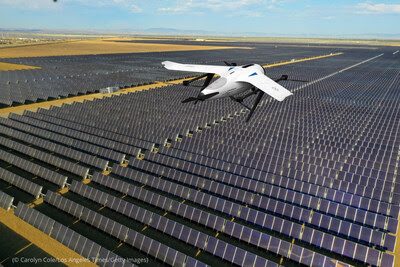
New research on hydrogen fuel cells could help hydrogen powered drone industry.
by DRONELIFE Staff Writer Ian J. McNabb
Hydrogen powered drones offer many significant benefits for the industry, including longer flight times and zero emissions. Hydrogen drones solve some of the challenges that batteries present, but hydrogen fuel cells have some challenges of their own: such as durability, performance degradation over time, and limited operating temperatures. New research is rapidly working to address these issues, not only for drones but for many types of vehicles.
A joint research team between Incheon University, based in Seoul, South Korea, and Harvard University recently announced an exciting new development in the world of hydrogen fuel cells, improving their durability through new fatigue-resistant membranes.
Hydrogen fuel cells require electrolyte membranes to divide the electrodes, which enable the flow of electricity through a substance. These essentially act as a gate, allowing protons through while inhibiting electrons, hydrogen molecules, and oxygen molecules. However, due to inconsistencies in operation (such as varying speeds), this membrane undergoes expansions and contractions which can cause deformations or cracks, ultimately leading to operational failure due to undesirable hydrogen movement. While there have been advances in membrane technology (including free scavengers and hydrocarbon electrolyte membranes), these flaws still significantly limit the lifespan of hydrogen fuel cells.
However, by introducing an interpenetrating network of Nafion, (a plastic electrolyte), and a rubbery polymer called perfluoropolyether (PFPE), the researchers believe they’ve found a solution that can vastly increase the lifespan and functionality of fuel cells. While the new combination (a 50% saturation of PFPE combined with the electrolyte) isn’t quite as performant as non-PFPE membranes, the new composite membrane is 175% more fatigue-resistant and offers a lifespan of up to 1.7x that of existing models with acceptable electrochemical performance.
Associate Professor Sang Moon Kim from Incheon University said, “To ensure the long-term stable operation of fuel cells, it is essential to develop an electrolyte membrane with high resistance to repetitive fatigue failure that reflects the actual operating environment and degradation process of fuel cells. In our study, we utilized an interpenetrating network to intentionally distribute repetitive stress.”
The long-term impact of this development may not be seen today, but in the long run, the new technology could have a significant impact on industries from hydrogen cars, to UAVs, to eVTOLs.
“Furthermore, the strategy for enhancing fatigue resistance can be extended and applied to ion filters, battery separators, and actuation systems. This allows for broad application in high-durability, long-life desalination filters, flow battery separators, lithium metal battery separators, and artificial muscles,” envisions Dr. Kim.
More information on the study is available here.
Read more:
- ZeroAvia and Verne Collaborate to Transform Hydrogen-Powered Aviation
- HevenDrones Introduces H2D200 Series, a Hydrogen-Powered Drone Line, at Monaco Hydrogen Forum
- Kelluu Hydrogen Powered Airships on the Drone Radio Show! Revolutionizing Aerial Data Collection
- Creating Hydrogen from Seawater Could Be a Game Changer for the Aerospace Industry
- Could Hydrogen Be the Power Source the Drone Industry is Looking for? [DRONELIFE Exclusive Op-Ed]
Ian McNabb is a staff writer based in Boston, MA. His interests include geopolitics, emerging technologies, environmental sustainability, and Boston College sports.
Miriam McNabb is the Editor-in-Chief of DRONELIFE and CEO of JobForDrones, a professional drone services marketplace, and a fascinated observer of the emerging drone industry and the regulatory environment for drones. Miriam has penned over 3,000 articles focused on the commercial drone space and is an international speaker and recognized figure in the industry. Miriam has a degree from the University of Chicago and over 20 years of experience in high tech sales and marketing for new technologies.
For drone industry consulting or writing, Email Miriam.
TWITTER:@spaldingbarker
Subscribe to DroneLife here.